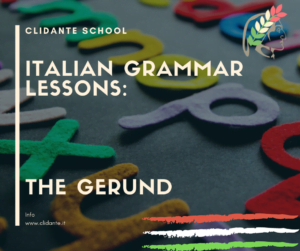Are you eager to learn Italian? Mastering Italian grammar, especially the gerund, is crucial for language learners. At our Italian language school for foreigners in the heart of Rome, we emphasize the importance of understanding and using Italian gramamr correctly. Let’s explore this essential aspect of Italian gerund together.
Understanding the Italian Gerund
The gerund is a fundamental part of Italian grammar that English speakers often find challenging. In English, the gerund ends in “-ing,” but in Italian, it’s a bit different. Let’s dive into how to use and form the gerund in Italian.
How to Use the Italian Gerund
Forming Continuous Tenses: The primary use of the gerund in Italian is to create continuous tenses. This verbal form can end in -ando or in -endo depending on the infinitive of the verb. For example, the verb to play in Italian is giocare and its gerund is giocando, instead the verb to know in Italian is sapere and its gerund is sapendo.
If you want to conjugate the present continuous you have to use the verb stare as auxiliary before the verb in gerund. For example, if you want to express I’m playing football you will say Sto giocando a calcio: you will use the verb “stare” followed by the gerund form of the verb to play (giocare).
If you want to conjugate the past continuous the auxiliary verb stare must be used in the past tense. For example, if you want to express I was playing football you will say Stavo giocando a calcio.
In Italian you use the gerund also when you want to express “when” something happened. For example the sentence When I came in I fell in Italian can be expressed with Entrando sono caduto. This verb form can be used to explain why something happened and in which circumstances.
Forming the Italian Gerund
To learn Italian grammar gerund forms, follow these rules:
- Verbs ending in -are: Replace -are with -ando Example: giocare (to play) → giocando (playing)
- Verbs ending in -ere or -ire: Replace the ending with -endo Example: sapere (to know) → sapendo (knowing) dormire (to sleep) → dormendo (sleeping)
Italian language has a lot of irregular verbs and for these you need to learn the exceptions. For example, for the verb bere (to drink) the gerund is not bendo, but it’s bevendo. We suggest you to read our guide about how to learn Italian verbs quickly, so that you will have the opportunity to improve your vocabulary and to have a large number of Italian verbs to use.
Practice Makes Perfect
To truly master Italian grammar: the gerund, consistent practice is key. At our language school in Rome, we offer immersive experiences to help you internalize these grammar rules naturally . At Clidante you’ll have
- Specialized Courses: Focus on challenging grammar aspects like the gerund.
- Interactive Lessons: Practice using the gerund in real-life scenarios.
- Cultural Excursions: Apply your grammar knowledge while exploring Rome.
Enhance Your Italian Skills with Us
Enroll in our courses today and take your Italian language skills to the next level. Experience the joy of learning Italian in Rome, where language and culture intertwine beautifully.
